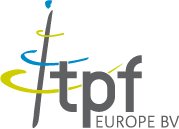Eliminating Muda, the 7 wastes: VSM, 5 S’s, Kanban, Kaizen, Heijunka, Jidoka, Poka Yoke, SMED, PDCA, DMAIC
VSM or Value Stream Mapping
As mentioned on the first page, for achieving flow the elimination of the 7 wastes or Muda is essential. VSM, Value Stream Mapping or Value Stream Analysis is an important tool for process and continuous improvement. The Value Stream Map aims at identifying all obstructions of the flow, since these obstacles are causing the 7 wastes. An element here is to compare actual processing time (value adding time) with actual lead time (value adding time + waste) per product or item. De time difference is considered a waste, since it can be seen as waiting. 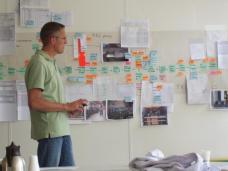
VSM can be done as part of a Kaizen Event: a multi disciplinary team maps all material and information flows, including "disturbances" leading to extra work, quality issues, delivery delay as well as potential improvements (the low hanging fruit as well as other improvement options).The visualisation is very important here, so that everybody can recognize the issues and items for improvement. Then the "future state" (desired state) is mapped. These improvements are to be further processed and implemented.
Very often the majority of the improvements are easy to realise at low or no cost. These improvements however lead to substantial savings: less stock, less handling, improved quality etcetera.
The 5 S’s : Workplace Organisation
You may wonder: What is 5S? The 5S methodology (or: Five S) is a structured program to implement workplace organisation and standardisation. 5S improves afety, work efficiency, productivity and ownership. And a well organised workplace motivates people.
The programme is called 5S, since all steps start with an "S".
 Sort deals with the contents of a workplace, and removes all items that are not needed there.
Set in Order refers to "a place for everything, and everything in its place" to enable easy acces to items.
Shine refers not just to cleaning, but to "being proud" about the way the workplace is organised.
Standardise refers to having standards that everyone has to adhere to. Visual management is an important aspect to facilitate easy undersanding of these standards.
Sustain refers to training of all employees and communication to all employees to ensure 5S application.
To initiate 5S one can very well use a Kaizen approach: this will help to show everybody how 5S helps to make work easier.The 5 S's facilitate an excellent performance:
Safety: a well organised and orderly workplace is a safer workplace. 5S activities remove clutter, visual indicators alarm people for hazardous situations.
Improving production efficiency: 5S supports a smooth production process in various ways. Searching for tools is eliminated, flow principles are applied, tools storage is done where they are needed most. Location indicators visualise how things have been organised, and non conformaties are seen at once.
Quality improvement: Daily activities like inspection help to keep the production process in the right condition. Defects are prevented, because deviations are spotted before they result into defects.
 Controlling your workplace: 5S helps with: Controlling your workplace: 5S helps with: determining what is needed, and where it is needed.
defining the appropriate location for tools and other materials.
maintaining these standards eliminating the 7 wastes in the workplace
Click here for the 5 S introduction video, which is part of the 5 S e training program.
Kanban and JIT: Just in Time
"JIT" means making "only what, when and in the amount needed". For example, to efficiently produce a large number of automobiles, which can consist of around 30,000 parts, it is necessary to create a detailed production plan that includes parts procurement. Supplying "what is needed, when it is needed, and in the amount needed" according to this production plan can eliminate the 7 wastes, inconsistencies, and unreasonable requirements, resulting in improved productivity.
Kanban System
In the TPS (Toyota Production System), a unique production control method called the "kanban system" plays an integral role. The kanban system has also been called the "Supermarket method" because the idea behind it was borrowed from supermarkets. These mass merchandizing stores use product control cards upon which product-related information, such as a product's name, code and storage location, are entered. Because Toyota employed kanban signs for use in their production processes, the method came to be called the "kanban system". At Toyota, when a process refers to a preceding process to retrieve parts, it uses a kanban to communicate which parts have been used. Two kinds (the poduction instruction and the parts retrieval kanban) are used for managing parts.

Evolution of the kanban through daily continuous improvement
Through continuous improvement, the system has evolved into the "e-kanban" which is managed using IT methodologies and has increased productivity even further.
Why use a supermarket concept?
A supermarket stocks the items for customers in the quantity that matches the sales, and it has all these items available for sale in the right quantity.
Taiichi Ohno (a former Toyota vice president), who promoted the idea of JIT, applied this concept, equating the supermarket and the customer with the preceding process and the next process, respectively. By having the next process (the customer) go to the preceding process (the supermarket) to retrieve the necessary parts when they are needed and in the amount needed, it was possible to improve upon the existing inefficient production system. No longer were the preceding processes making excess parts and delivering them to the next process.(This explanation is from the Toyota site)
Kaizen Event
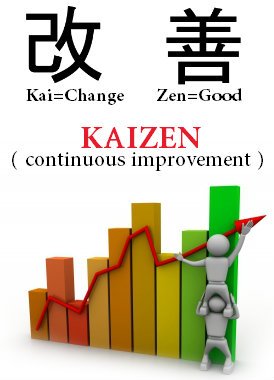
The step wise continuous improvement process as described by Masaaki Imai in his book "Kaizen" shows how many small improvements contribute tremendeously to improving overall performance. This is contrary to the "big leap" approach that is sometimes preferred. In order to facilitate or speed up the continuous improvement process it can be helpful to have a so-called Kaizen Event or Blitz. The Kaizen Meaning or definition: The word "Kai" means change, the word "Zen" means good, therefore in English it most often translated as continuous improvement.
A Kaizen Event is a 3-5 day event in order to have improvement potential indentified AND implemented. A Kaizen Event is usually organised with the following rules in mind:
Multi disciplinary team consisting of operators, managers and owners of the process
Mapping the existing process, for example VSM
Identify and implement improvements on the existing process
Solicits buy-in from all parties related to the process
A Kaizen Event is an extremely powerful and efficient way to quickly improve a process and to eliminate waste. The intent of a Kaizen Event is to hold small events attended by the owners and operators of a process to make improvements to that process which are within the scope of the process participants.
Heijunka or production leveling
Production leveling, also known as production smoothing or by its Japanese original term heijunka is a technique for reducing the Mura (Unevenness) which in turn reduces Muda (waste). The goal is to produce intermediate goods at a constant rate so that further processing may be carried out at a constant and predictable rate. Where demand is constant, production leveling is easy, but where customer demand fluctuates, two approaches have been adopted: 1) demand leveling and 2) production leveling. To prevent fluctuations in production, even in outside affiliates, it is important to minimize fluctuation in the final assembly line. Toyota's final assembly line never assembles the same automobile model in a batch. Instead, they level production by assembling a mix of models in each batch and the batches are made as small as possible.
Production leveling can refer to leveling by volume, or leveling by product type or mix. A Heijunka Box is used to visualise the production sequence
Leveling by volume
Suppose for a family of products that use the same production process there is a demand that varies between 800 and 1,200 units. Toyota's view is that production systems that vary in the required output suffer from mura and muri with capacity being 'forced' in some periods. So their approach is to manufacture based on long-term average demand and carry an inventory proportional to the variability of demand, stability of the production process and the frequency of shipments. So for 800-1,200 units, if the production process were 100% reliable and the shipments once a week, then the production would be with minimum standard inventory of 200 at the start of the week and 1,200 at the point of shipment. The advantage of carrying this inventory is that it can smooth production throughout the plant and therefore reduce process inventories and simplify operations which reduces costs.
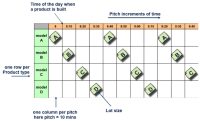
Leveling by product
Most value streams produce a mix of products and therefore face a choice of production mix and sequence. It is here that the discussions on economic order quantities take place and have been dominated by changeover times and the inventory this requires, like the Camp formula to calculate optimum batch size. Toyota's approach resulted in a reduction of the duration of changeovers so that smaller and smaller batches could be produced and lost production time and quality costs were not significant. This meant that demand for components could be leveled for upstream sub-processes and therefore lead time and total inventories could be reduced along the entire value stream. To simplify leveling of products with different demand levels a visual scheduling board known as a heijunka box is often used. Once leveling by product is achieved then the last leveling phase is "Just in Sequence" where leveling occurs at the lowest level of production, also eliminating 7 wastes.
More information on the implementation method can be found at: Production Leveling
Jidoka
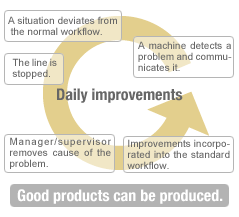
The English translation for Jidoka is: "automation with a human touch". Jidoka refers to a machine that has a built-in device to do judgements. The aim is to avoid any defective products being produced. So when the device recognises any defects, it will stop the machine. In this way, it helps the operator to signal quality devations. Since equipment stops when a problem arises, a single operator can visually monitor and efficiently control many machines.
As an important tool for this "visual control" or "problem visualization" Toyota uses a display board system called "Andon" that helps operators to identify issues in the production line at a glance.
Poka Yoke
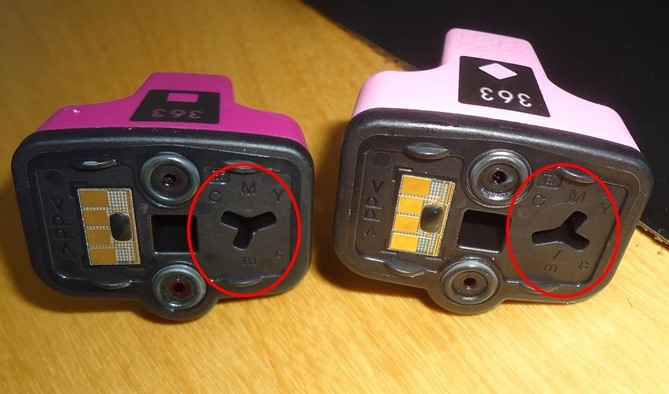
Poka Yoke is another way to eliminate quality issues and to ensure "first time right". It is also seen as making things "fool proof": the intention is that it cannot go wrong, so that even a "fool" can do it correctly. There are many examples available, often a mechanical fit which results in only one type of "fit". The photograph shows two different HP cartridges for the Photosmart printer: only one colour fits in each of the positions, since the cartidges have a different "cut" leading to only one postition where the cartridge fits.
Single Minute Exchange of Dies: SMED changeover time reduction
These modern times of rapidly increasing diversity and smaller batch sizes, setup time reduction is of crucial importance for the profitability of many companies.
In some industries with many changeovers and high cleaning standards (like the food and pharmaceutical industries) sometimes more than 20% of the planned production time is spent on changeovers. Fortunately, these setup and changeover times can be reduced significantly when the SMED changeover system is applied. The SMED system has a proven track record in many types of industries. The goal is to "Reduce changeovers from hours to minutes".
Single Minute Exchange of Dies (SMED) is the best approach to reduce output and quality losses due to changeovers. The method has been developed in Japan by Shigeo Shingo, and has proven its effectiveness in many companies by reducing changeover times from hours to minutes. "The flow must go on", was Shigeo's reaction when he witnessed changeover times of more than 1 hour. Remember that waiting is one of the 7 wastes, so it needs to be dealt with. Based on his huge experience, he developed a method to analyse the changeover process, enabling local personnel to find out themselves why the change over took so long, and how this time can be reduced. In many cases, change over and setup times can be reduced to less then ten minutes, so the change over time can be expressed with one single digit, and is therefore called "Single Minute Exchange of Dies".
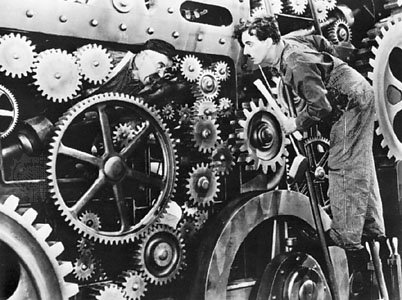 This analysis consists of the following 4 phases:
1. mixed phase
2. separated phase
3. transferred phase
4. improved phase
The method has a systematic approach to analyse what is actually done and how time is spent during the changeover activity. Through the analysis, a better understanding is gained on how certain activities can be done when the line is running. Also it is determined, what can be done to reduce the "fine tuning" activities after the actual changeover.
|
